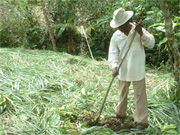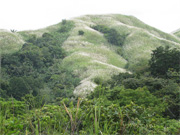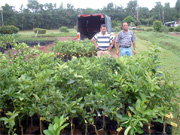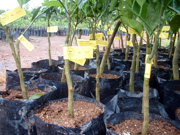Project News
2010-04-30
Tree Planting Activities
One of the Project’s activities is to restore the soil by planting trees. Steep slopes with high risk of erosion, within and nearby the group farms, are identified as “critical areas” where citrus trees are planted or agroforestry activities are applied.
 Citrus trees are planted along the edges of creeks to conserve the water resource as well as to create shade to diminish the growth of canal grass. (October 2, 2009 at the Chilibrillo community)
Citrus trees are planted along the edges of creeks to conserve the water resource as well as to create shade to diminish the growth of canal grass. (October 2, 2009 at the Chilibrillo community)
 The canal grass is a perennial weed that invades clear-cut land and prevents the regeneration of the forest. (September 10, 2009 on the path to Quebrada Fea community)
The canal grass is a perennial weed that invades clear-cut land and prevents the regeneration of the forest. (September 10, 2009 on the path to Quebrada Fea community)
Through planting citrus tress on their group farmland, many groups have learned how to plant and care for tree seedlings as well as grafting techniques. The Project team gives technical assistance to the groups and provides certified “disease-free seedlings” from a nursery in Cocle Province.
 The C/P Eric (left) and Luis (right) visiting the citrus tree nursery. (September 26, 2009 in Cocle Province)
The C/P Eric (left) and Luis (right) visiting the citrus tree nursery. (September 26, 2009 in Cocle Province)
 Each seedling has the certificate from the National Department of Plant Health. (September 26, 2009 in Cocle Province)
Each seedling has the certificate from the National Department of Plant Health. (September 26, 2009 in Cocle Province)
As a rule, cutting and using trees inside the national park is prohibited. Also, there are organizations that pay farmers to plant trees. Such circumstances tend to lower the priority of tree planting activities without pay among the groups’ various activities. However, we plan to introduce the use of native tree species which are more attractive to the farmers and to expand the activities into the critical areas.
(Mr. Taku MORI, Farmland use plan / Environmental Education)
